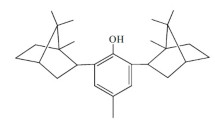Abstract
The absorption, distribution and elimination of carnosic acid, the main antioxidant found in rosemary was studied, in vivo, in rats. Therefore, carnosic acid was administrated in a single dose, intravenously (20.5 ± 4.2 mg/kg) and orally (64.3 ± 5.8 mg/kg), to four and nine rats, respectively. Blood samples were collected at different time points, and plasma concentrations of carnosic acid were determined using LC-MS. Furthermore, total collection of urine and feces was done during 4 h and 24 h for the intravenous and oral administrations, respectively. After euthanizing the rats, intestinal content, liver and muscle tissue were sampled to determine carnosic acid concentrations. The bioavailability of carnosic acid, after 360 min, was 40.1%. Traces of carnosic acid were found in the rats intestinal content, liver and muscle tissue of abdomen and legs. The recovery of carnosic acid in the feces, 24 h after oral administration, was 15.6 ± 8.2%. Carnosic acid is absorbed into the bloodstream after oral administration in rats and is therefore bioavailable. It was found that carnosic acid in vivo is present in its free form and that its main elimination route is the fecal route.


Similar content being viewed by others
Abbreviations
- AUC:
-
area under the curve
- CA:
-
carnosic acid
- F:
-
bioavailability
- IV:
-
intravenous
- PO:
-
oral
- RA:
-
rosmarinic acid
- RE:
-
rosemary extract
References
Richheimer SL, Bernart MW, King GA, Kent MC, Bailey DT (1996) Antioxidant activity of lipid-soluble phenolic diterpenes from rosemary. J Am Oil Chem Soc 73:507–514
Aruoma OI, Halliwell B, Aeschbach R, Löliger J (1992) Antioxidant and pro-oxidant properties of active rosemary constituents: carnosol and carnosic acid. Xenobiotica 22:257–268
Frankel EN (1998) Lipid oxidation. The Oily Press Ltd., Dundee
Balentine CW, Grandall PG, O’Bryan CA, Duong DQ, Pohlman FW (2006) The pre- and post-grinding application of rosemary and its effects on lipid oxidation and color during storage of ground beef. Meat Sci 73:413–421
Ahn J, Grün IU, Mustapha A (2007) Effects of plant extracts on microbial growth, color change, and lipid oxidation in cooked beef. Food Microbiol 24:7–14
Mielnik MB, Aaby K, Skrede G (2003) Commercial antioxidants control lipid oxidation in mechanically deboned turkey meat. Meat Sci 65:1147–1155
Estevez M, Ramirez R, Ventanas S, Cava R (2007) Sage and rosemary essential oils versus BHT for the inhibition of lipid oxidative reactions in liver pâté. J Food Sci Technol 40:58–65
Haak L, Raes K, De Smet S (2009) Effect of plant phenolics, tocopherol and ascorbic acid on oxidative stability of pork patties. J Sci Food Agric 89:1360–1365
Lopez-Bote CJ, Gray JI, Gomaa EA, Flegal CJ (1998) Effect of dietary administration of oil extracts from rosemary and sage on the lipid oxidation in broiler meat. Br Poult Sci 39:235–240
Galobart J, Barroeta AC, Baucells MD, Codony R, Ternes W (2001) Effect of dietary supplementation with rosemary extract and α-tocopheryl acetate on lipid oxidation in eggs enriched with ω3-fatty acids. Poultry Sci 80:460–467
O’Grady MN, Maher M, Troy DJ, Moloney AP, Kerry JP (2006) An assessment of dietary supplementation with tea catechins and rosemary extract on the quality of fresh beef. Meat Sci 73:132–143
Smet K, Raes K, Huyghebaert G, Haak L, Arnouts S, De Smet S (2008) Lipid and protein oxidation of broiler meat as influenced by dietary natural antioxidant supplementation. Poult Sci 87:1682–1688
Gladine C, Morand C, Rock E, Bauchart D, Durand D (2007) Plant extracts rich in polyphenols (PERP) are efficient antioxidants to prevent lipoperoxidation in plasma lipids from animals fed n-3 PUFA supplemented diets. J Anim Feed Sci Technol 136:281–296
Krause E, Ternes W (2000) Bioavailability of the antioxidative Rosmarinus officinalis compound carnosic acid in eggs. Eur Food Res Technol 3:161–164
Yan H, Wang L, Li X, Yu C, Zhang K, Jiang Y, Wu L, Lu W, Tu P (2009) High-performance liquid chromatography method for determination of carnosic acid in rat plasma and its application to pharmacokinetic study. Biomed Chromatogr 23:776–781
Cuvelier ME, Richard H, Berset C (1996) Antioxidative activity and phenolic composition of pilot-plant and commercial extracts of sage and rosemary. J Am Oil Chem Soc 73:645–652
Lee HB, Blaufox MD (1985) Blood volume in the rat. J Nucl Med 25:72–76
Smet K, Raes K, De Smet S (2006) Novel approaches in measuring the antioxidative potential of animal feeds the FRAP and DPPH methods. J Sci Food Agric 86:2412–2416
Mateos R, Espartero JL, Trujillo M, Rios JJ, Leon-Camacho M, Alcudia F, Cert A (2001) Determination of phenols, flavones, and lignans in virgin olive oils by solid-phase extraction and high-performance liquid chromatography with diode array ultraviolet detection. J Agric Food Chem 49:2185–2192
Andreasen MF, Kroon PA, Williamson G, Garcia-Conesa M-T (2001) Intestinal release and uptake of phenolic antioxidant diferulic acids. Free Radical Biol Med 31:304–314
Doolaege EHA, Raes K, Smet K, Andjelkovic M, Van Poucke C, De Smet S, Verhé R (2007) Characterization of two unknown compounds in methanol extracts of rosemary oil. J Agric Food Chem 55:7283–7287
Armbruster DA, Tillman MD, Hubbs LM (1994) Limit of detection (LOD)/ limit of quantification (LOQ): comparison of the empirical and the statistical methods exemplified with GC-MS assays of abused drugs. Clin Chem 40:1233–1238
Gladine C, Morand C, Rock E, Gruffat D, Bauchart D, Durand D (2007) The antioxidant effect of plant extracts rich in polyphenols (PERP) differs between liver and muscle tissues in rats fed n-3 PUFA rich diets. J Anim Feed Sci Technol 139:257–272
Acknowledgements
EHAD is grateful for the financial support offered by BOF Ghent University.
P. Joye and J. Vermeiren (UGent) are thanked for the technical assistance in the rat experiments. P. Zwaenepoel is thanked for technical assistance during LC-MS analyses.
Author information
Authors and Affiliations
Corresponding author
Rights and permissions
About this article
Cite this article
Doolaege, E.H.A., Raes, K., De Vos, F. et al. Absorption, Distribution and Elimination of Carnosic Acid, A Natural Antioxidant from Rosmarinus officinalis, in Rats. Plant Foods Hum Nutr 66, 196–202 (2011). https://doi.org/10.1007/s11130-011-0233-5
Published:
Issue Date:
DOI: https://doi.org/10.1007/s11130-011-0233-5




